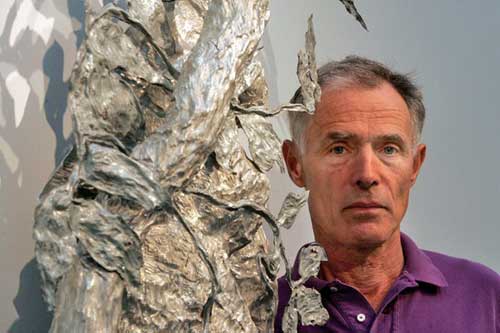
 Sculpture News at SculptSite.com
Sculpture News at SculptSite.com
Robert Lobe Sculpture |
| SIGNON San Diego News By Robert L. Pincus UNION-TRIBUNE ART CRITIC / BOOKS EDITOR Plato crystallized a concept that has never become obsolete: art as an imitation of nature. The 20th century rebelled against this concept, of course, with the invention of abstraction. But mirroring or interpreting the world, as we encounter it, hasn't diminished all that much, though abstraction flourished. Even the advent of a host of new media, which stretch the boundaries of image-making, can't cancel out our desire to depict the physical world. This line of thought naturally comes to mind while spending time with the sculptures of Robert Lobe, on view at the Lux Art Institute. His subject, in a literal sense, is trees, rocks and leaves. He sculpts them in aluminum, galvanized iron and, more recently, in stainless steel with a great attention to detail. But the part stands for the whole in his art, too. See a portion of one tree or an immense ridge of rock sculpted and your mind's eye can't help but envision a larger landscape. There are seven works in the Lux's gallery, one of which was completed during his four-week residency there. There are two additional sculptures located outdoors, one a cast bronze and the other a large-scale work in aluminum. All were made during the last decade, with one exception dating from 1994. The art itself has a directness, since it is made largely by hammering the metal to fit the form. So, the very form of the tree or rock stands before you. This may sound simple in style, but actually it isn't. Lobe isn't interested in trying to create the illusion of a tree in aluminum. The seams where metal meets metal are easy to decipher and he clearly wants you to see them. And there are always openings through which you can peer into the interior of the sculpture and note that it's hollow. What might look as if it could be excessively heavy is relatively light. It's realism with all of its artifice exposed, drawing attention to the gap between the real thing and the image of it, which makes his art modernist in spirit. There is no one-to-one correspondence in Lobe's work between the natural object and the sculpture, either. In "Latin Lovers," the piece he crafted at the Lux, he's joined the form of a rock, taken from a location in Rancho Santa Fe, to that of a tree on the grounds of the Lux. It's a kind of study in contrast, in which weightiness and delicacy meet. Pieces like this can be exhibited indoors or out. They're done in heat-treated aluminum, which means that the metal goes through the same process as the outer skin of a jet. In fact, the largest work in the Lux gallery, "Butterfly" (2001), spent some years outdoors at a site in Northern California and looks no worse for the wear. It displays the subtle virtues of Lobe's art: the way the stump of a tree can become a shimmering circle in the context of a sculpture, and the way a tiny form can enhance our sense of the scale of a form. Near the top of the tree's trunk in this sculpture is the form of a butterfly. Lobe's works mounted on the wall are akin to sculptural still lifes, since he's creating compositions out of natural forms much as a painter would. "May" is in this vein, its right edge defined by the form of a cropped branch that juts out like an arm planted on a hip. In the middle is a modest section depicting stone, which tapers to a point. On the left is a small section of leaves on stems, a delicate counterpoint to the branch. The origins of Lobe's hammered forms stretch back to the 1970s, when he was creating what he called "Stone Clones." The use of trees and leaves, which began in the mid-1980s, has given his work a wider variety, a richer vocabulary. Lobe's aesthetic is low-key, even when the scale is large. His work doesn't try to muscle its way into our field of vision. It looks at home in a natural setting but at the same time sets up a situation in which you detect its harmony with and departure from the place in which you find it. The big sculpture, "Mother Maple," fits in nicely with Lux's landscape, even as it depicts a tree what wouldn't be found there. And bringing natural forms inside a galley setting, as much of his exhibition does, creates a different scenario - one in which you contemplate natural form as you might not out in the world and experience the ways in which the artist has altered nature, aestheticizing it in ways that the please the eye. |
 A very gifted artist who creates shape and form in a most wonderful way! As usual, a nicely crafted articel by Robert L. Pincus |
 |
More Sculpture News ....
Submit your SCULPTURE NEWS.
It's easy, just send us an e-mail
(click on Submit News in the left menu) with your pertinent information along with images, we'll take care of the rest. Sculpture makes our world a much better place in so many ways!
SculptSite.com, along with Sculptors and their creative genius all helping to bring the beauty and message of Sculpture to a hurried world.

